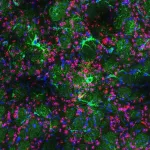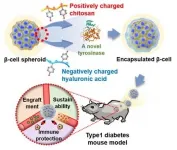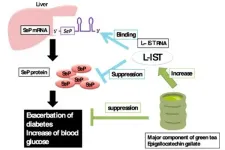(Press-News.org) UNIVERSITY PARK, Pa. -- It can be difficult to get young kids to eat enough vegetables, but a new Penn State study found that simply adding more veggies to their plates resulted in children consuming more vegetables at the meal.
The researchers found that when they doubled the amount of corn and broccoli served at a meal -- from 60 to 120 grams -- the children ate 68% more of the veggies, or an additional 21 grams. Seasoning the vegetables with butter and salt, however, did not affect consumption.
The daily recommended amount of vegetables for kids is about 1.5 cups a day, according to the official Dietary Guidelines for Americans as set by the U.S. Departments of Agriculture and Health and Human Services.
"The increase we observed is equal to about one third of a serving or 12% of the daily recommended intake for young children," said Hanim Diktas, graduate student in nutritional sciences. "Using this strategy may be useful to parents, caregivers and teachers who are trying to encourage kids to eat the recommended amount of vegetables throughout the day."
Barbara Rolls, Helen A. Guthrie Chair and director of the Laboratory for the Study of Human Ingestive Behavior at Penn State, said the findings -- recently published in the journal Appetite -- support the MyPlate guidance from the U.S. Department of Agriculture, which recommends meals high in fruits and vegetables.
"It's important to serve your kids a lot of vegetables, but it's also important to serve them ones they like because they have to compete with the other foods on the plate," Rolls said. "Parents can ease into this by gradually exposing kids to new vegetables, cooking them in a way their child enjoys, and experimenting with different flavors and seasonings as you familiarize them."
According to the researchers, the majority of children in the U.S. don't eat the recommended daily amount of vegetables, which could possibly be explained by children having a low preference for them. And while serving larger portions has been found to increase the amount of food children eat -- called the "portion size effect" -- kids tend to eat smaller amounts of vegetables in response to bigger portions compared to other foods.
For this study, the researchers were curious if increasing just the amount of vegetables while keeping the portions of other foods the same would help increase veggie consumption in kids. They also wanted to experiment with whether adding light butter and salt to the vegetables would increase their palatability and also affect consumption.
For the study, the researchers recruited 67 children between the ages of three and five. Once a week for four weeks, the participants were served lunch with one of four different preparations of vegetables: a regular-sized serving of plain corn and broccoli, a regular-sized serving with added butter and salt, a doubled serving of plain corn and broccoli, and a doubled serving with added butter and salt.
During each meal, the vegetables were served alongside fish sticks, rice, applesauce and milk. Foods were weighed before and after the meal to measure consumption.
"We chose foods that were generally well-liked but also not the kids' favorite foods," Rolls said. "If you offer vegetables alongside, say, chicken nuggets you might be disappointed. Food pairings are something you need to be conscious of, because how palpable the vegetables are compared to the other foods on the plate is going to affect the response to portion size. You need to make sure your vegetables taste pretty good compared to the other foods."
After analyzing the results, the researchers found that while the larger portions of vegetables were associated with greater intake, the addition of butter and salt was not. The children also reported liking both versions -- seasoned and unseasoned -- about the same. About 76% of kids rated the vegetables as "yummy" or "just ok."
"We were surprised that the butter and salt weren't needed to improve intake, but the vegetables we served were corn and broccoli, which may have been already familiar to and well-liked by the kids," Diktas said. "So for less familiar vegetables, it's possible some extra flavoring might help to increase intake."
Diktas said that while serving larger portions may increase vegetable consumption, it also has the potential to increase waste if kids don't eat all of the food that is served.
"We're working on additional research that looks into substituting vegetables for other food instead of just adding more vegetables," Diktas said. "In the future, we may be able to give recommendations about portion size and substituting vegetables for other foods, so we can both limit waste and promote veggie intake in children."
INFORMATION:
Liane Roe, research nutritionist; Kathleen Keller, associate professor of nutritional sciences; and Christine Sanchez, lab manager at the Laboratory for the Study of Human Ingestive Behavior, also participated in this work.
The National Institute of Diabetes Digestive and Kidney Diseases helped support this research.
Rude behavior at work has come to be expected, like donuts in the breakroom. Two decades of research on employee relationships shows that 98 percent of employees experience rude behavior at work, but now a new study suggests a large majority of workplace relationships are not characterized by rudeness. Isolated incidents of rude behavior at work, although somewhat common, do not point to widespread incivility between employees and their colleagues, according to a new UCF study.
"Because prior research suggests workplace mistreatment is harmful and widespread, it is often called an epidemic, but our findings show that rude behavior is less like the flu and more like cholera," says Shannon Taylor, an associate professor of management and co-author of the ...
Berlin and Bath, 24th June 2021 - Precision-fermentation company Formo and the University of Bath co-published the first large-scale study of consumer acceptance for animal-free dairy products.
Researchers surveyed 5,054 individuals from Brazil, Germany, India, the UK, and the USA to understand what consumers think of animal-free dairy products.
Precision fermentation is a process that allows specific proteins to be produced via microorganisms. By inserting a copied stretch of cow DNA, microorganisms produce milk proteins. The process is more efficient than using animals to make proteins and avoids the negative side effects of industrial animal agriculture, which is responsible for 18% of all greenhouse gas emissions.
The findings of the study, published in ...
Leukemia is a group of blood cancers that affects thousands of people worldwide. However, with advances in medicine, several different types of leukemia can be effectively treated with donor stem cells through allogenic stem cell transplantation (allo-SCT). One such type of leukemia is B-cell acute lymphoblastic leukemia (B-ALL), which is caused by uncontrolled proliferation and prolonged existence of cancerous B-cells. While allo-SCT can 'cure' B-ALL in several cases, there are also cases of failure, characterized by deterioration in health after a period ...
The brain is not a passive recipient of injury or disease. Research has shown that when neurons die and disrupt the natural flow of information they maintain with other neurons, the brain compensates by redirecting communications through other neuronal networks. This adjustment or rewiring continues until the damage goes beyond compensation.
This process of adjustment, a result of the brain's plasticity, or its ability to change or reorganize neural networks, occurs in neurodegenerative conditions such as Alzheimer's, Parkinson's and Huntington's disease (HD). As the conditions progress, many genes change the way they are normally expressed, turning some genes up and others down. The challenge for researchers like Dr. Juan Botas ...
The central goal of cloud computing is to provide fast, easy-to-use computing and data storage services at a low cost. However, the cloud environment comes with data confidentiality risks attached.
Cryptography is the primary tool used to enhance the security of cloud computing. This mathematical technique protects the stored or transmitted data by encrypting it, so that it can only be understood by intended recipients. While there are many different encryption techniques, none are completely secure, and the search continues for new technologies that can counter the rising threats to data privacy and security.
In a recent study published in KeAi's International Journal of Intelligent Networks, a team of researchers from India and Yemen describe a novel, two-step cryptography ...
A research team, led by Prof. Nathaniel S. Hwang and Prof. Byung-gee Kim, from Seoul National University (SNU) and Prof. Dong Yun Lee, from Hanyang University, has used enzymatic crosslinking to create nanofilms on cell surfaces. SNU has announced that it has developed a "cell caging" technology for the applications in cell-based therapies. The "cell caging" technique can prevent immune rejection during heterologous islet cell transplantation, facilitate smooth cell insulin secretion, and treat type 1 diabetic patients without immunosuppressants.
The research team succeeded in producing a nanofilm by using the electrostatic force to stack chitosan, which is a biological polymer, and hyaluronic acid in that order. To overcome the shortcomings ...
Across the world, type 2 diabetes is on the rise. A research group has discovered a new gene that may hold the key to preventing and treating lifestyle related diseases such as type 2 diabetes.
The results of their research were published in the journal Nucleic Acids Research on June 18, 2021.
Selenoprotein P (SeP) is an essential plasma protein containing the micronutrient selenium. However, too much SeP spells trouble.
Excess SeP increases insulin resistance, thus weakening the effect of insulin, and worsening the metabolism of glucose.
"Excess SeP is the enemy when it comes to type 2 diabetes," stressed professor Yoshiro Saito from the Graduate School of Pharmaceutical Sciences at Tohoku University and co-author of the ...
Female elephant seal weigh on average 350 kg, and dive continuously to the ocean's mesopelagic zone, about 200 to 1,000 meters deep, to consume their only prey: small fish that weigh less than 10 grams. Now, an international team of researchers, armed with eight years of data, may have answered a decades-long question: How do seals maintain their large size on such small prey?
They published their answer on May 12 in Science Advances.
"It is not easy to get fat," said paper author Taiki Adachi, research fellow with the National Institute of Polar Research and the School of Biology, University of St Andrews. "Elephant seals have to spend almost ...
Genome study reveals East Asian coronavirus epidemic 20,000 years ago
An international study has discovered a coronavirus epidemic broke out in the East Asia region more than 20,000 years ago, with traces of the outbreak evident in the genetic makeup of people from that area.
Professor Kirill Alexandrov from CSIRO-QUT Synthetic Biology Alliance and QUT's Centre for Genomics and Personalised Health, is part of a team of researchers from the University of Arizona, the University of California San Francisco, and the University of Adelaide who have published their findings in the journal Current Biology.
In the past 20 years, there have been three outbreaks of epidemic severe coronaviruses: ...
In the 1950s, researchers made the first unexpected discoveries of dinosaur remains at frigid polar latitudes. Now, researchers reporting in the journal Current Biology on June 24 have uncovered the first convincing evidence that several species of dinosaur not only lived in what's now Northern Alaska, but they also nested there.
"These represent the northernmost dinosaurs known to have existed," says Patrick Druckenmiller of the University of Alaska Museum of the North. "We didn't just demonstrate the presence of perinatal remains--in the egg or just hatched--of one or two species, rather we documented at ...







